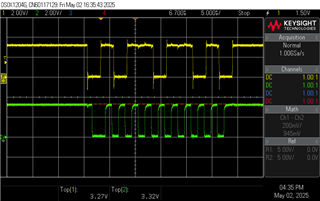Other Parts Discussed in Thread: DAC80516,
Tool/software:
Hi there,
I recently acquired the DAC80516 Evaluation Board and am currently trying to communicate with it. As an initial attempt, I tried using the GUI for High and Low-level configurations, but I didn’t get any noticeable results.
I then decided to use an I2C ID scan, which I had used previously to test other chips (it worked for them), directly on the accessible pins of the board (J15).
All jumpers are in the default configuration except for the following:
-
J16 – disconnected (to disconnect FTDI from the bus)
-
J17 – disconnected (to disconnect FTDI from the bus)
-
J18 – I2C-A0 = GND
-
J19 – I2C-A0 = GND
I then tried testing some power supply values, but nothing changed. I can observe the two-wire bus on the oscilloscope, but I never get the scan to return the expected 0x50 ID.
Thank you in advance for your assistance.
Best regards,
Jean



